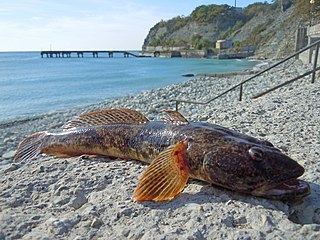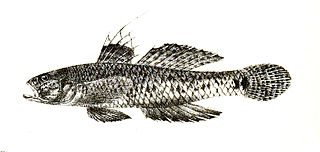
The round goby is a fish. Defined as a euryhaline bottom-dwelling goby of the family Gobiidae, it is native to central Eurasia, including the Black Sea and the Caspian Sea. Round gobies have established large non-native populations in the Baltic Sea, several major Eurasian rivers, and the North American Great Lakes.

Nemateleotris magnifica, known by a variety of common names including fire goby, magnificent fire fish, fire dartfish, or red fire goby is a species of dartfish native to the Indian and Pacific oceans from the eastern coast of Africa to the Hawaiian Islands and from the Austral Islands north to the Ryukyu Islands. It is an inhabitant of coral reefs where it can be found at depths of from 6 to 70 metres. It is usually found just above the bottom, facing into the current, where it awaits its prey of small invertebrates.
The Dalhousie goby is a species of goby endemic to Australia where it lives in the Dalhousie Springs. It feeds on small molluscs, crustaceans and other odds and ends like most other gobies. This species can reach a standard length of 4.5 centimetres (1.8 in).
Croilia mossambica, the burrowing goby or naked goby, is a species of goby native fresh, brackish and marine waters of Mozambique, South Africa and Madagascar. This species can be found on fine-grained sandy substrates in still waters at depths of from 1 to 16 metres. It can reach a length of 6 centimetres (2.4 in) TL. It is currently the only known member of its genus.
Economidichthys trichonis, the Trichonis dwarf goby, is a species of goby endemic to Lake Trichonis, an oligotrophic lake in western Greece, where it can be found at depths down to 15 metres (49 ft) in vegetated areas. Males of this species can reach a length of 3 centimetres (1.2 in) TL while females grow to 2.7 centimetres (1.1 in) TL. This species is the smallest freshwater fish in Europe with a mature female measuring only 1.8 centimetres (0.71 in) SL.

The sleepy goby is a species of fish in the family Gobiidae.
Glossogobius hoesei, Hoese's goby, is a species of goby endemic to the Ayamaru Lakes in West Papua, Indonesia where it can be found on muddy or gravel substrates as well as in small tributary streams. This species can reach a length of 7 centimetres (2.8 in) SL. The specific name honours the ichthyologist Douglass Fielding Hoese of the Australian Museum in Sydney who has made an important contribution to the study of fishes in the order Gobiiformes.
Glossogobius matanensis is a species of goby endemic to Sulawesi, Indonesia where it is only known from Lake Matano, Lake Mahalona and Lake Towuti. This species can reach a length of 42 centimetres (17 in) TL.

Mesogobius batrachocephalus, the knout goby or toad goby, is one of the species of gobiid fish native to the Black Sea and the Sea of Azov basins. It lives in estuaries and brackish water lagoons, occasionally in fresh waters, such as the coastal Lake Siutghiol in Romania. It prefers areas near cliffs with sandy, shelly or rocky substrates at depths of from 20 to 60 metres, sometimes down to 100 metres (330 ft). The knout goby is a piscivore. It can reach a length of 34.5 centimetres (13.6 in) SL and weight of 600 grams (1.3 lb). Maximum known age is eight years.

Favonigobius reichei, the Indopacific Tropical Sand Goby, is a species of goby native to fresh, brackish and marine waters of coastal areas of the Indian Ocean and the western Pacific Ocean preferring muddy or sandy substrates, often with weed growth. This species can reach a length of 8.3 centimetres (3.3 in) TL.

Pomatoschistus canestrinii, Canestrini's goby, is a species of goby native to fresh and brackish waters along the Adriatic coasts where it is known to occur from the Po delta, Italy to Neretva, Croatia. It has also been introduced in Lake Trasimeno, Italy. This species prefers areas with sand or mud substrates in lagoons, lakes and medium-sized to large-sized rivers. This species can reach a length of 5.5 centimetres (2.2 in) TL. The specific name honours the Italian biologist Giovanni Canestrini (1835-1900).
Redigobius dewaali, the Checked goby, is a species of goby native to the Indian Ocean coast of Africa from Mozambique and South Africa. This species inhabits fresh and brackish waters of estuaries, lakes and floodplain pans where there is plentiful vegetation. It can reach a length of 4.2 centimetres (1.7 in) SL.
Silhouettea is a genus of gobies native to the Indian Ocean and the western Pacific Ocean. The name of this genus refers to the island of Silhouette in the Seychelles where the type specimens of the type species, Silhouettea insinuans, were collected.
The bearded eelgoby, also known as the bearded goby, is a species of goby endemic to South Africa where it inhabits muddy areas of mangrove swamps, estuaries and rivers. This species can reach a length of 12 centimetres (4.7 in) TL.

The spotfin goby cichlid is an African species of cichlid endemic to Lake Tanganyika where it is only known from the northern end of the lake. They live amongst pebbles in the surf-zone. This species can reach a length of 7 centimetres (2.8 in) TL. This species can also be found in the aquarium trade. Although presently considered the only species in the genus, another undescribed species is known from the Lukuga River.

Glossogobius giuris, the tank goby, is a species of goby native to fresh, marine and brackish waters from the Red Sea and East Africa through South Asia and the Indian Ocean to China, Australia and the islands of the Pacific Ocean. This species can also be found in the aquarium trade. It is also known as the bar-eyed goby, flat-headed goby and the Gangetic tank goby.

Fries's goby is a species of goby native to the Eastern Atlantic Ocean along the coasts of Europe and northern Africa as well as the Mediterranean Sea to the Sea of Marmara. This species burrows into muddy or muddy sand substrates at depths of from 10 to 130 metres and is frequently found in association with the Norway lobster Nephrops norvegicus. This species can reach a length of 13 centimetres (5.1 in) TL. The specific name honours the Swedish zoologist Bengt Fredrik Fries (1799-1839).

Oxyurichthys microlepis, the maned goby, is a species of goby native to tropical marine and brackish waters along the coasts of the Indian Ocean from Africa to the western Pacific Ocean where it occurs in estuaries and inshore waters to depths of about 75 metres (246 ft). It occurs in the Mekong Delta and is suspected to use the tidal flow up the river to reach as far inland as Cambodia. This species can reach a length of 13.5 centimetres (5.3 in) TL. It is of minor importance to local commercial fisheries and can also be found in the aquarium trade.

Potamonautes sidneyi is a species of freshwater crab in the family Potamonautidae. The common name is the Natal river crab or Sidney's river crab, although they may also be referred to as "river crabs", "fresh water crabs" or "land crabs".
The Red Sea goby is a species of true goby from the family Gobiidae. It was once a species confined to the Red Sea but it has colonised the Suez Canal and the south-eastern Mediterranean by Lessepsian migration.











